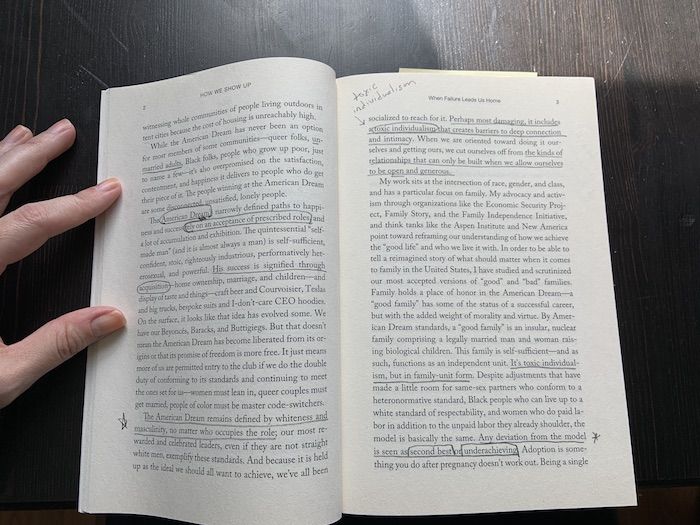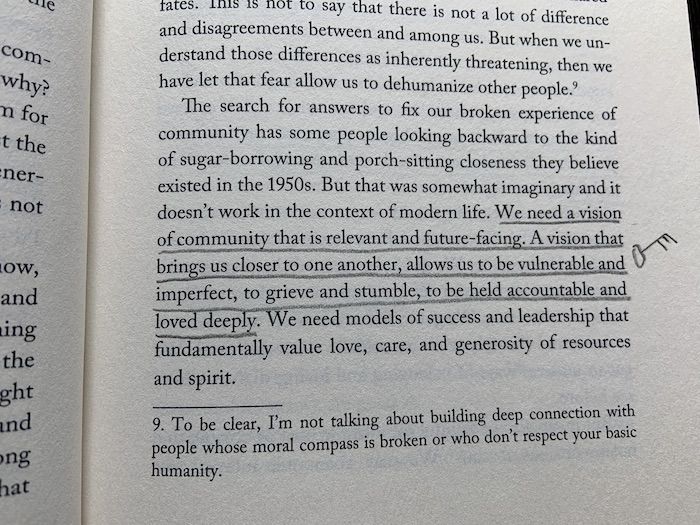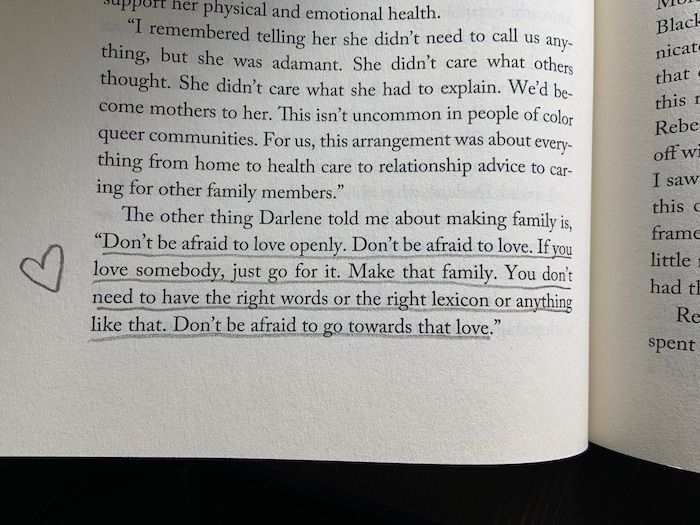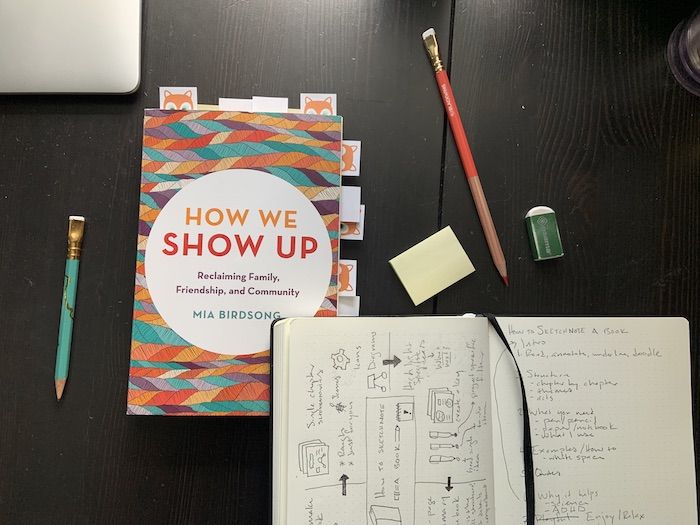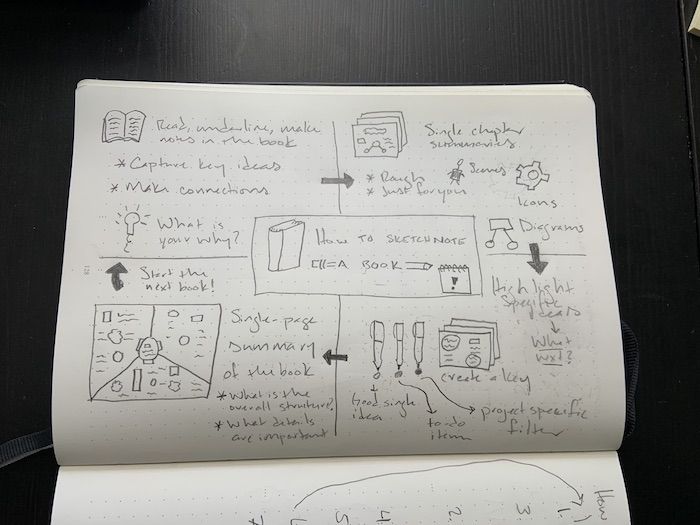Sketchnoting is that next step. It’s a type of note taking that includes visual components to make it more pleasing to the eye and engaging for the brain. Often this can be the act of hand lettering, where the words themselves are the art. Adding drawing to note taking activates different areas of the brain that aren’t used with note taking alone. I have written about my fresh ADHD diagnosis before. Since I’m still less than a year from diagnosis, I’m searching for strategies and tools that work for how my brain is wired. Sketchnoting helps me focus and remember what I’ve read. By adding a visual to a key concept, my brain can hold on to the information better. It’s also a lot of fun, makes my notebooks a joy to flip back through, and makes it easier to find particular information I’ve written down. When you search the internet or Instagram for sketchnoting, it can be intimidating to see the amazingly artistic results. Never fear. I have come here with my super humble notebook and practically nonexistent artistic skill to show you how to sketchnote a book, and how simple it can be.
Read and Annotate
The first step to sketchnoting a book is to read the book. While reading, underline sentences or phrases that impact you. Draw stars or symbols in the margins. Write yourself notes. This is where you are mining information you want to remember or come back to later. Margin symbols are especially helpful because it can help you quickly find what kind of concept or idea you are looking for. I like to use stars for important ideas, hearts for things that elicited an emotional response for me, and keys for key concepts.
Gather What You Need
All you really need is something to write with and something to write on. This could be a crayon and children’s menu at a restaurant. It could be card stock and a fountain pen or printer paper and a ballpoint pen. I prefer to use my Bullet Journal, a Blackwing pencil, and a colored pencil. I like being able to erase and rearrange on the page. Having all my notes together in one place helps me not lose anything. Ryder Carroll has said that he invented The Bullet Journal Method to help him manage his ADHD. It’s been an invaluable tool for me as well. The dotted pages that come with the Leuchtturm1917 help me keep letters a consistent size, draw straighter lines, and arrange things evenly (or more evenly) on the page. Also, the dots fade into the background when I look at completed sketchnote pages, whereas lines distract me from the notes.
Getting Started
I watched this video on how to sketchnote a book and took my own notes copying what Doug Neill did. It was nice to follow how he divided the page and watch how he drew his doodles so I could copy him and practice. The thing with drawing is that it’s like any other skill: the more you practice the better you get at it. When you think about it, pick up a pencil and doodle whatever is on your mind. Doodle while on the phone or in a meeting. It can help you focus on what’s being said and improve drawing ability. Or you can do what I did and watch videos of people doodling to copy how they created their images and build confidence. Just starting is also an excellent strategy. Don’t let the perfect be the enemy of the good, as they say. These notes are just for you, and no one else has to see them. They don’t need to be posted online or out in the open.
Structure
Nonfiction books are what I prefer to sketchnote. They usually have a table of contents and built in structure that’s easy to follow. In this example, I’m sketchnoting Mia Birdsong’s How We Show Up: Reclaiming Family, Friendship, and Community. I decided to give each chapter its own page in my notebook. I wanted to capture key ideas, themes, and quotes that stood out to me. The ways to organize your notes are as endless and the ideas you have. You could choose a theme and write down important points from all throughout the book that relate to that theme. If you want to sketchnote a work of fiction, you could break it down in a three or five act structure. You could go chronologically or order of importance.
Examples
The chapter one page is my first attempt at sketchnoting this book. I labeled the chapter, focused on the theme of the illusion of the American dream that Birdsong discusses at length in the book. At the bottom, I added color to highlight what we should be moving toward and what I thought were the most important points of the first chapter. Now look at the next page where I made notes on chapter two. Here, I decided to leave off writing out “chapter 2” because the 2 in the box is enough delineation for me to know where these notes are coming from. Also, Birdsong’s chapter titles are descriptive, so I wanted them to be the focus of the top of the page. On the chapter 1 page, I feel like the title is too cramped without enough white space. Empty space on the page is just as much part of the notes as the doodles are. Try to avoid cluttering your notes because it’s not as pleasing to see, and the busy pages may be harder to remember. On the chapter 2 page, I decided to make a web organizer. The main idea of this chapter was that we as people need to reorient ourselves around what it means to be an individual. All the ideas presented in this chapter relate back to that one main idea. I included a doodle of a stick person isolated in a bubble and a small community trying to reach that person. I also included a direct quote from chapter two: “We can’t know ourselves without other people.” This quote is one I underlined when reading that really impacted me. There’s more white space on this page than the first one. I was tempted to fill every empty space, but I like the look of this simple note and am glad that I didn’t make it too busy.
Enjoy
Finally, be sure that you enjoy this process. It’s a technique that’s supposed to help and relax you, not add more stress or another item on your to do list. Sketchnoting is a way to play and experiment where the stakes are exceptionally low and the rewards can be pretty big. It’s something you can do just for yourself and for your brain. This is a quiet form of self-care that is low cost. Sketchnoting has become a regular practice alongside my reading, especially nonfiction. It’s relaxing and satisfying. It feels good to look down on a full page, even when that page is mostly stick figures. Spending time listening to lo-fi beats while drawing and going deeper on a book I enjoyed has become my favorite de-stressing activity at home. I hope that you give it a shot and that my exceedingly imperfect pages inspire you to know that something doesn’t have to be post-worthy to be creative or beneficial. We can do things simply because we like them.
